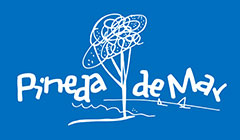Until 1900, only the ends of the street you are in were developed. The central part was still a greenfield, and it was called the ‘under the village’ area. Changes in Pineda due to the population growth collided with a new urban plan that was unable to absorb the dwelling demand.
In 1859, the railway line reached Pineda, and this fact enabled and accelerated the beginning of the summer holiday phenomenon. Within this context, some dwellings, such as those that you can see in this part of this street, were built; e.g. houses No. 46 and 52, Cal Comandant (1901) and Can Ribera (1902), respectively.
These are some good examples of Art Nouveau architecture, with both symmetrical and austere decorations. These are ground and first storey houses, with a small entrance or yard in front, which is ideal for chilling out in the afternoon and enjoying the views of the promenade!
An 800-metre street that connects Plaça Catalunya with the sea. It was opened in 1499 by the viscounts of Cabrera, in order to facilitate the movement of people and goods by sea.
The objective of the opening of the street was to facilitate economic transactions, especially the exchange of grain and livestock, as despite the piracy, shipping was much faster and more secure than by land. Before the opening of Carrer del Mar, the products were mostly received on the beach, but only through little torrent beds and ditches, which were inadequate, since between the centre of Pineda and the sea there was no thoroughfare established.
On July 6th, 1499 the viscounts of Cabrera -Frederic Enríquez and Anna de Cabrera- bought from Antoni Torroella (merchant), Joan Cànoves (owner of Can Cànoves) and Joan Serra del Pla, a strip of land with a width of 16 Pams from Camí Ral to the beach. For these plots the viscounts paid 27 pounds in the currency of Barcelona, before Bernat Torroella, at the notary of Montpalau. They rebuilt and enabled the way, and three days later they sold it for the same price to the University of Pineda, which was the precedent of the current town council.
A regulation of use was established for the transit of goods and people. In particular, the payment of a fee was established: “the people of the town of Calella, the Capaspre Valley and the Santa Susanna Valley, who have not paid nor contributed to the toll to share the cost of this passage.”
Despite the use of the road until practically the eighteenth century, nothing was built on Carrer de Mar due to piracy. Once the danger disappeared, the fishermen’s quarter was established at the head of the street, known as the Raval de Mar.
Until the 19th century only the ends of the street were urbanized and the central part was used for agricultural fields for fields, known as “sota vila” or “under town”.
This part of Carrer de Mar, called Raval de Mar, was urbanised from the middle of the 18th century, once the pirates had already ceased to represent a danger for the residents, although the road was used continuously to transport goods.
The fishermen built the so-called “kitchen houses”, small houses very close to the beach, where they worked. They had a kitchen on the ground floor, a bedroom on the first floor and two patios, one at the back and the other at the front. The front yard made it possible to extend the house-kitchen to the street line, if the economic situation allowed it. In the backyard there was the vegetable garden and it was the place where the fishing nets were fixed.
Until the 20th century, the Raval de Mar was separated from the centre of Pineda. The central part of the street was not urbanised, the sota vila agricultural fields were there.
The change began with the arrival of the railroad to the village and with the consequent arrival of travellers from Barcelona, following the new trend of summer holidaying. The Arenys-Tordera line was opened in 1859, including a stop at Pineda de Mar.
Wealthy Barcelona families began to arrive at the town and they contributed to the growth of Pineda. Between the years 1890 and 1930 summer homes started to be built along Carrer de Mar, which was completely built up in the 1970s. In 1950 the stretch of Carrer de Mar was urbanised, between the streets Comtal and Progrés, and in the 60s, apartment blocks were built, completing the entire street.
.




